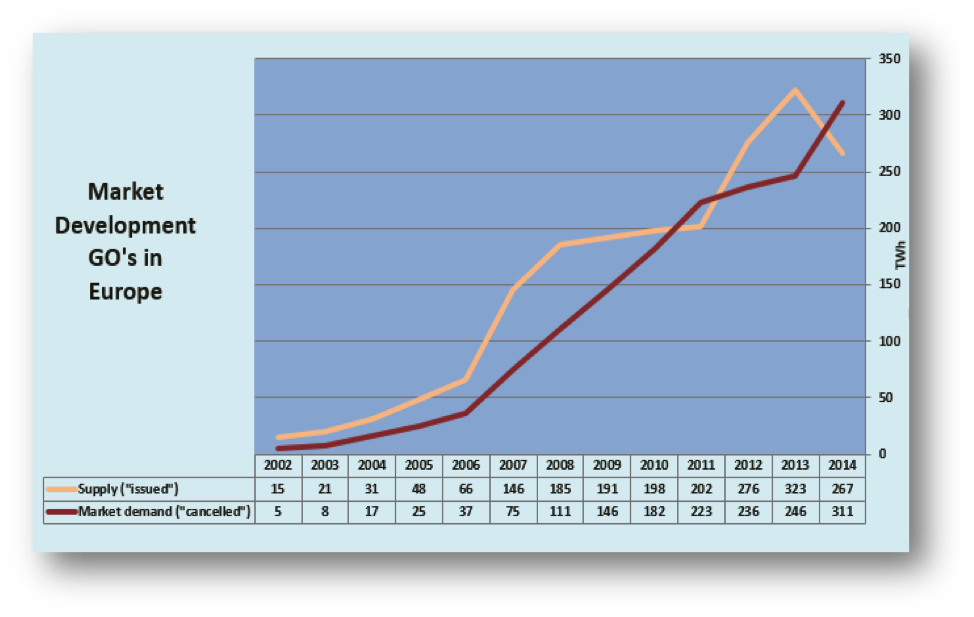Renewable Energy Demand Surges In 2014
Originally published on Energy Post.
The European market for renewable energy, documented with Guarantees of Origin, increased by 26.5 % in 2014 compared to 2013. For the first time, the demand surpassed 300 TWh, according to statistics from the Association of Issuing Bodies (AIB). This is nearly one tenth of all electricity demand in Europe (ca. 3,300 TWh) and one-third of all electricity from renewable sources in Europe (ca. 900 TWh). Chip in a few dollars a month to help support independent cleantech coverage that helps to accelerate the cleantech revolution!
Chip in a few dollars a month to help support independent cleantech coverage that helps to accelerate the cleantech revolution!
The figures have been announced by ECOHZ, a Norwegian company that offers renewable energy with Guarantees of Origin (GO) to electricity providers, businesses and organisations. “These encouraging statistics suggest a breakthrough for Guarantees of Origin, and an increasing momentum for renewable energy consumption overall”, says Tom Lindberg, Managing Director of ECOHZ.

Except for 2011, 2014 is the first year with a large deficit of Guarantees of Origin in the market. The deficit amounts to 44 TWh. “When the market experienced a deficit in 2011, the market pushed up the price of Guarantees of Origin. How the market will adapt to today’s situation is unclear. Because of the 12-month validity-policy deployed by member countries, there is still a “warehouse” of Guarantees of Origin available from earlier periods. In the next few months, this stock will empty and we may see a real balance between supply and demand”, says Lindberg.
The official statistics from AIB include reported market figures from member states. But the figures partially or totally exclude data from Slovenia, Spain and Sweden. These countries all have working systems for supplying, purchasing and trading of renewable energy certificates. When the missing market figures from Slovenia, Spain and Sweden are added to AIB’s statistics, the adjusted market demand totals approximately 400 TWh, 28% higher than AIB’s market figures.
The United Kingdom uses a different renewable energy certificate system, REGO, and is not included in any of the mentioned market figures.
Some other results, as reported by ECOHZ:
- Germany continues to drive the market. It reached a total demand volume of 81 TWh, up by an impressive 65% from 2013.
- Just behind Germany, Sweden is a clear number two with a Guarantees of Origin demand of more than 71 TWh.
- Holland, Italy, Switzerland, Finland, and Norway all show strong growth, with market demand ranging from 25 TWh to 40 TWh.
- Hydro still dominates the market with more than 80% of the Guarantees of Origin volumes. Bio and Wind nearly doubled their volumes, and total almost 50 TWh. Geothermal and Solar also increased sharply, but volumes are still low.
- 2014 saw four new countries (Croatia, Czech Republic, Cyprus and Estonia) taking the first steps into the market and will fully take part in the market in 2015.
- Norway is still the leading country supplying Guarantees of Origin. Norway provided the market with approximately 130 TWh of Guarantees of Origin from Hydro in 2014. As the rest of the market keeps ramping up, Norway’s share of the total supply continues to decrease.
According to ECOHZ, households, organizations and businesses, all contribute to the impressive market growth, but “undeniably, the corporate sector is the main driver. Global reporting initiatives like CDP (Carbon Disclosure Project) and the Greenhouse Gas Protocol, as well as EU’s recently approved CSR Directive, emphasize that renewable energy is an important part of a broad corporate sustainability agenda. Guarantees of Origin is the primary tool in Europe to document the purchase of renewable energy.”
(Source: ECOHZ, . www.ecohz.com, @ecohz @tomlindberg99. Note that on 29-30 April the annual RECS market meeting will take place in Oslo, organised by the trade assocation of renewable energy traders.)
Have a tip for CleanTechnica? Want to advertise? Want to suggest a guest for our CleanTech Talk podcast? Contact us here.
Latest CleanTechnica.TV Video

CleanTechnica uses affiliate links. See our policy here.
